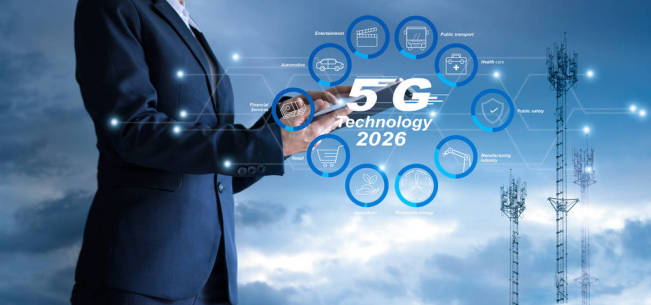5G and the Internet of Things: a new era of digitalization

By integrating 5G and IoT networks, manufacturers can
operate fully and flexibly and move towards a dynamic ecosystem composed of
suppliers and consumers.
There is no doubt that 5G mobile networks will be a huge
leap in mobile broadband. The Internet of Things provides 5G with many
advantages in the fields of healthcare, education, energy, and transportation.
According to recent research, approximately 500 billion IoT tools, including
sensors, medical devices, and actuators, will be connected to the Internet.
These IoT devices will collect, aggregate and analyze
data across multiple platforms and services. Therefore, 5G networks are
imperative to meet the needs of these types of data-intensive IoT devices.
The researchers' focus is on the impact of the combination
of the Internet of Things and 5G on our society and its costs. The introduction
of 5G will modernize the industry and provide emerging technologies such as the
Internet of Things to unleash its full potential.
According to Ericsson AB's latest mobile report, there will
be approximately 600 million 5G users next year. At the same time, the
Asia-Pacific region will become the second fastest growing region, with 5G
users accounting for about 10% of the total number of users.

Advantages of 5G and the Internet of Things
In fact, because of fiber optic cables, 5G networks are very
fast and reliable, so they will provide speed, efficiency, security, latency,
and reliability. Therefore, it will provide greater flexibility and the same
capacity at a lower price. The introduction of 5G will lead to improvements in
mobile broadband services. Digital capabilities based on virtual reality,
autonomous operation, artificial intelligence and drones will become one of the
solutions with 5G networks to improve productivity and efficiency.
The Internet of Things is rapidly being adopted, and we can
predict that in less than five years, there will be more investment in Internet
of Things gadgets. Profits can be generated in IoT devices, thereby attracting
manufacturers, such as reducing machine downtime, improving product quality,
predictive maintenance and informed decision-making. Due to wireless
technology, 5G will eliminate some of the current limitations in the Internet
of Things, but it will not be able to solve problems such as vibration, sound,
and heat.
Interrelated efforts
Internet of Things merchants are currently focusing on
meeting the precise and practical requirements of the industry and providing
more reliable solutions to meet customer needs. In addition, with the
introduction of 5G networks, it will be possible for IoT platforms to connect
to discrete solutions and point sensors to monitor the entire process from
R&D to the end of the product development cycle.
The Internet of Things and 5G will play an important role in
creating an integrated ecosystem to optimize the life cycle of manufacturing,
distribution, and product consumption. From the planning to the sales process,
various industries can be continuously connected to each stage. In addition,
analysts and decision makers can verify data through sensors installed
throughout the entire supply process of manufacturers and their consumers.
Data will flow back and forth in the entire multidimensional
ecosystem, rather than in a straight line. Therefore, the ecosystem will allow
rapid response to possible changes and interruptions in consumer demand. IoT
devices will enable us to obtain large amounts of data. This will prove to be a
boon for analysis, as they will be able to take preventive planning and
maintenance to refurbish their products in this situation.
The ecosystem created by 5G and the Internet of Things will
introduce the era of smart manufacturing, because customizable products and
manufacturing procedures can be optimized.
What the research on 5G and the Internet of Things found
- By 2024, machines equipped with 5G and the Internet of Things represent a $1.2 billion global opportunity.
- 5G is essential for a built-in private wireless network that supports reliable IoT applications.
- By 2024, 5G edge computing application revenue will increase by 40% of total infrastructure expenditure.
- The largest vertical industry designed for MEC will be produced in 2024. This will be driven by private LTE and 5G networks in the industrial sector.
- 5G will optimize the Internet of Things network by using radio frequency management to meet the needs of narrowband Internet of Things applications and applications that require higher bandwidth.
- Due to the arrangement of low-power WAN IoT network capacity, IoT solutions will benefit from the implementation of 5G.
- From the perspective of the impact of the Internet of Things on the daily lives of customers and enterprise systems, the scope of the Internet of Things will continue to expand
Improve liquidity
Let us give an example here. Employees equipped with
enhanced VR/AR headsets will be able to move freely in the factory, and they
will be continuously connected to the 5G network. These workers can simulate
each process in the three dimensions while interacting with IoT devices, until
the final product.
VR/AR's ability to use simulation to detect faults
happens to be one of the most valuable features of this particular system. In
addition, these industries can use network slicing to integrate 5G networks
into their digital strategies. In addition, it will allow merchants and
consumers to integrate into the platform. Therefore, the combination of the
Internet of Things and 5G will make it possible to realize Industrial
Revolution 4.0.
Manufacturers do not have to rely on fixed and mobile
networks to meet their communication requirements. The flexible manufacturing
that 5G can provide requires mobility. The industry may shift from unreliable
Wi-Fi networks.
5G network options
The industry prefers to implement its digital
transformation strategy through a dedicated network. In this way, they will be
able to use the combination of 5G and the Internet of Things.
There are many options for private networks: work with an
existing telecommunications provider to run the entire system, or create a
system that can run independently.
Due to the competition for bandwidth among consumers,
companies and the public sector, governments are now focusing on opening up
more 5G spectrum. In addition, 5G networks are vulnerable to cyber attacks.
Therefore, we hope that manufacturers can obtain strong network security
protocols with secure and innovative software algorithms and network slicing.
Therefore, unlike the infrastructure currently in use, 5G will provide a
stronger level of data security.
The future of 5G-IoT
By integrating 5G and IoT networks, manufacturers can
operate fully and flexibly and move towards a dynamic ecosystem composed of
suppliers and consumers. It is now up to individuals to take full advantage of
Industrial Revolution 4.0. Due to the integration of 5G and the Internet of Things,
the Industrial Revolution has made a huge leap.